Current Weather Outlook
Statewide weather outlook from Florida Division of Emergency Management Meteorology
Monday, December 15, 2025
...Cold Start for North Florida As Arctic Air Has Arrived...Slow Warming Conditions for North Florida, Temperatures May Not Even Reach 50-Degrees Today...Breezy Winds Conditions Continue Across the State, Strongest Gusts Along Southeast Florida Coast - Wind Advisory...Possible Sprinkles or Brief Showers Along East Coast...Elevated Wildfire Conditions Return to North Florida...Another Round of Widespread Freeze Conditions Across North Florida Today With Frost Possible...Cooler Temperatures to Dip into the State As Breezy Winds Subside...Dangerous Rip Current Risk Statewide...High Surf Advisories Along East Coast...
Updated at 9:52 AM EST
Today's Threats:
|
No Threat |
Low Threat |
Medium Threat |
High Threat |
|
Lightning |
Tornado |
Damaging Wind/Hail |
Wildfire |
Freeze (Overnight) |
Fog (Overnight) |
Coastal Flooding |
Rip Currents |
| Iso. South FL |
North Florida |
Interior North Florida Coastal North Florida Iso. Nature Coast |
E. Panhandle and Peninsula W. Panhandle & Nature Coast |
![]()
Weather Summary for the Next 24 Hours:
A cold and chilly start this morning across North Florida as arctic air has pushed into the state behind yesterday’s cold front. Breezy winds will gradually ease up this morning across North Florida and sunshine will return. Yesterday’s cold front will linger around South Florida and the Keys today creating breezy wind conditions across Central and South Florida, with the strongest wind gusts along the coastlines. Wind gusts will reach upwards of 15-25 mph inland and 25-35 mph closer towards the coast. A Wind Advisory remains in effect along coastal Southeast Florida through this evening for those stronger wind gusts closer to 35 mph possible throughout the day. Breezy onshore winds along the East Coast, an upper-level feature and the cold front will help to push moisture onshore towards the I-95 corridor leading to brief isolated showers (15-35% chance of rain). The best chance for shower activity, or maybe even a rumble of thunder, will remain along the Southeast Florida coastline throughout the day. Otherwise, mostly dry conditions can be expected for the rest of the state as drier air filters southward. With drier conditions returning to North Florida, along the lingering breezy winds, an elevated wildfire risk returns this afternoon as relative humidity values will dip below critical thresholds (20-30%).
Cool conditions will keep high temperatures in the middle to upper 40s across North Florida and possibly the lower 50s closer towards the coast, but temperatures will struggle to warm up today. Breezy winds across the Peninsula will help to keep conditions slightly cooler as well, and high temperatures will reach the 60s across Central Florida and 70s in South Florida this afternoon.
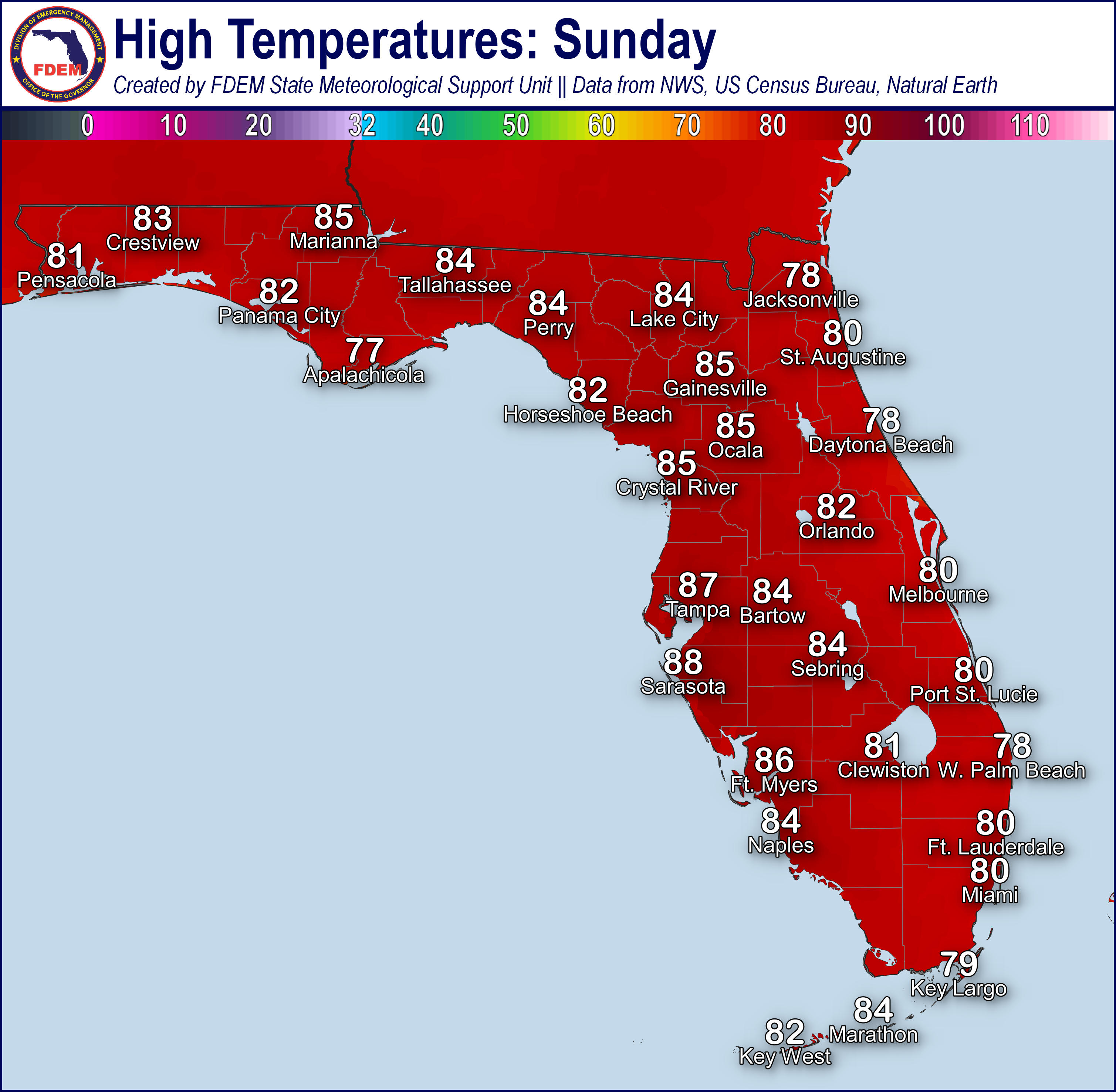
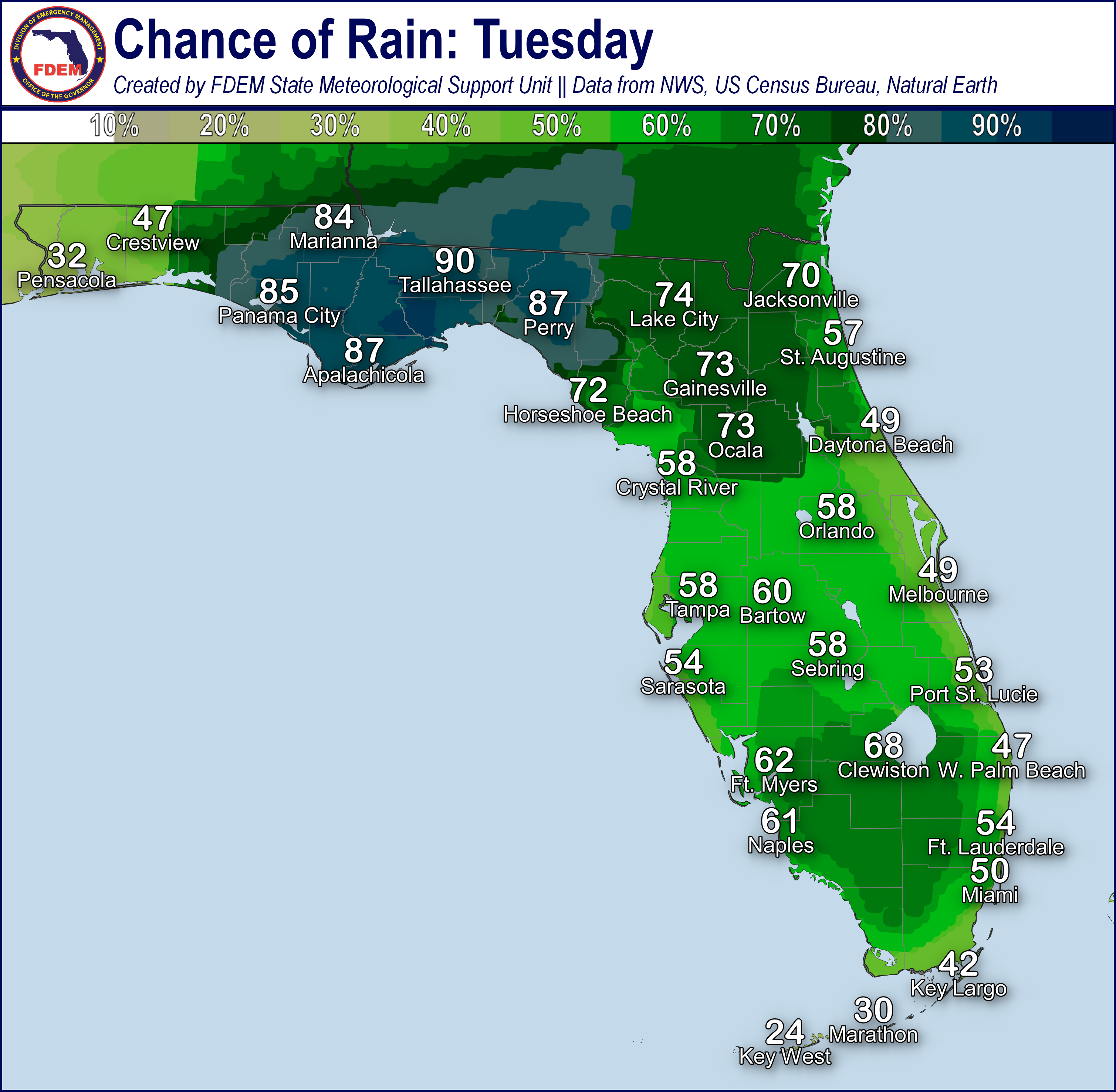
Dry conditions will persist into the overnight hours throughout the state. A few lingering sprinkles or even a brief shower may continue along the East Coast and towards the I-95 corridor, but activity will remain light and brief (15-35% chance of rain).
Clear skies and lighter winds tonight will allow temperatures across North Florida to fall back into the middle 20s to lower 30s overnight. Calm winds will help to keep feels-like temperatures near the actual temperatures overnight. Freeze Warnings will go into effect overnight across portions of the Panhandle and Northeast Florida for sub-freezing conditions, but not quite hard freeze conditions. Lighter winds will also help to lead to instances of frost development, especially in more shaded areas overnight. Low temperatures across Central Florida will reach the middle 30s to upper 40s. South Florida will see low temperatures in the 50s to middle 60s.
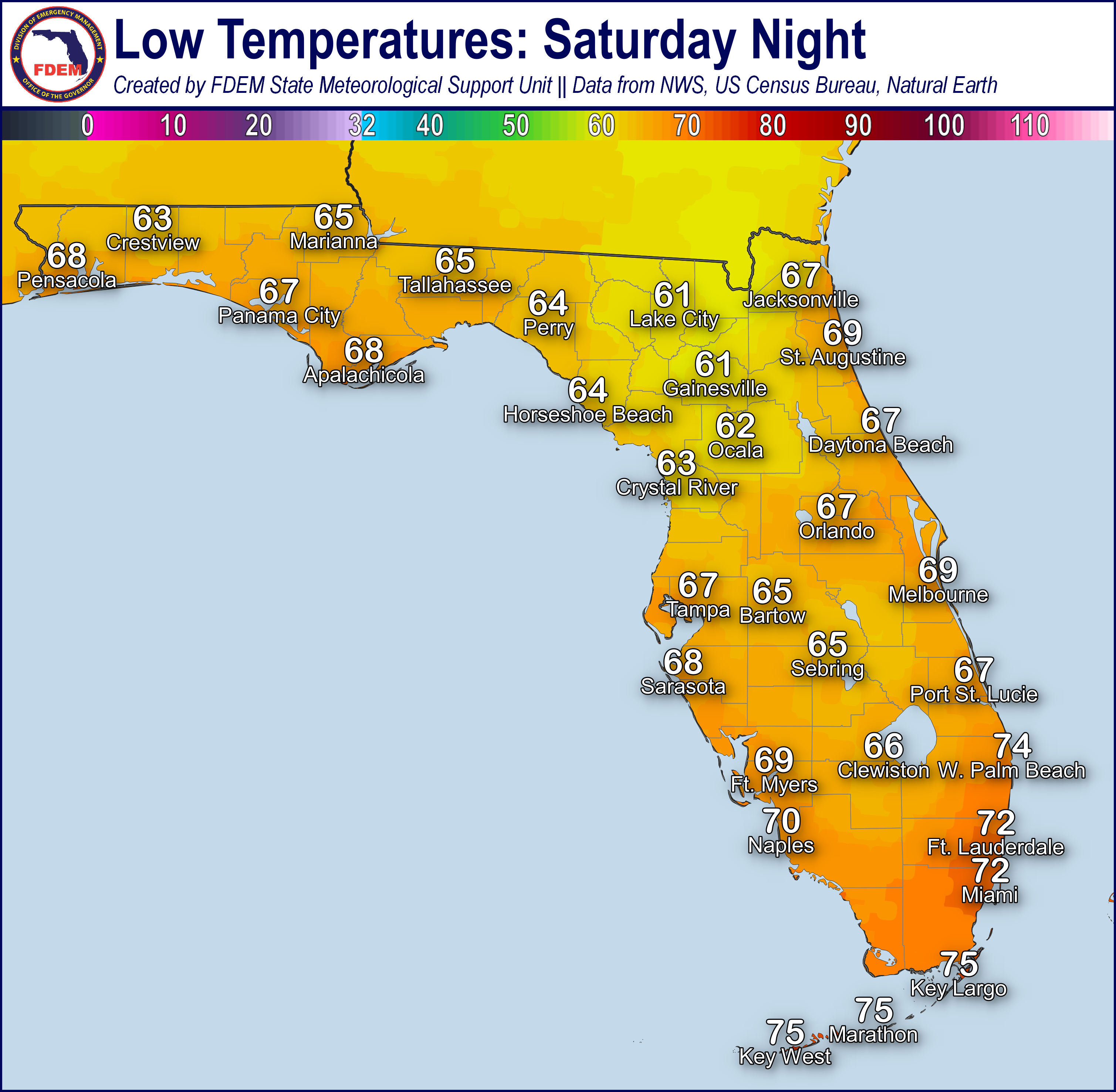
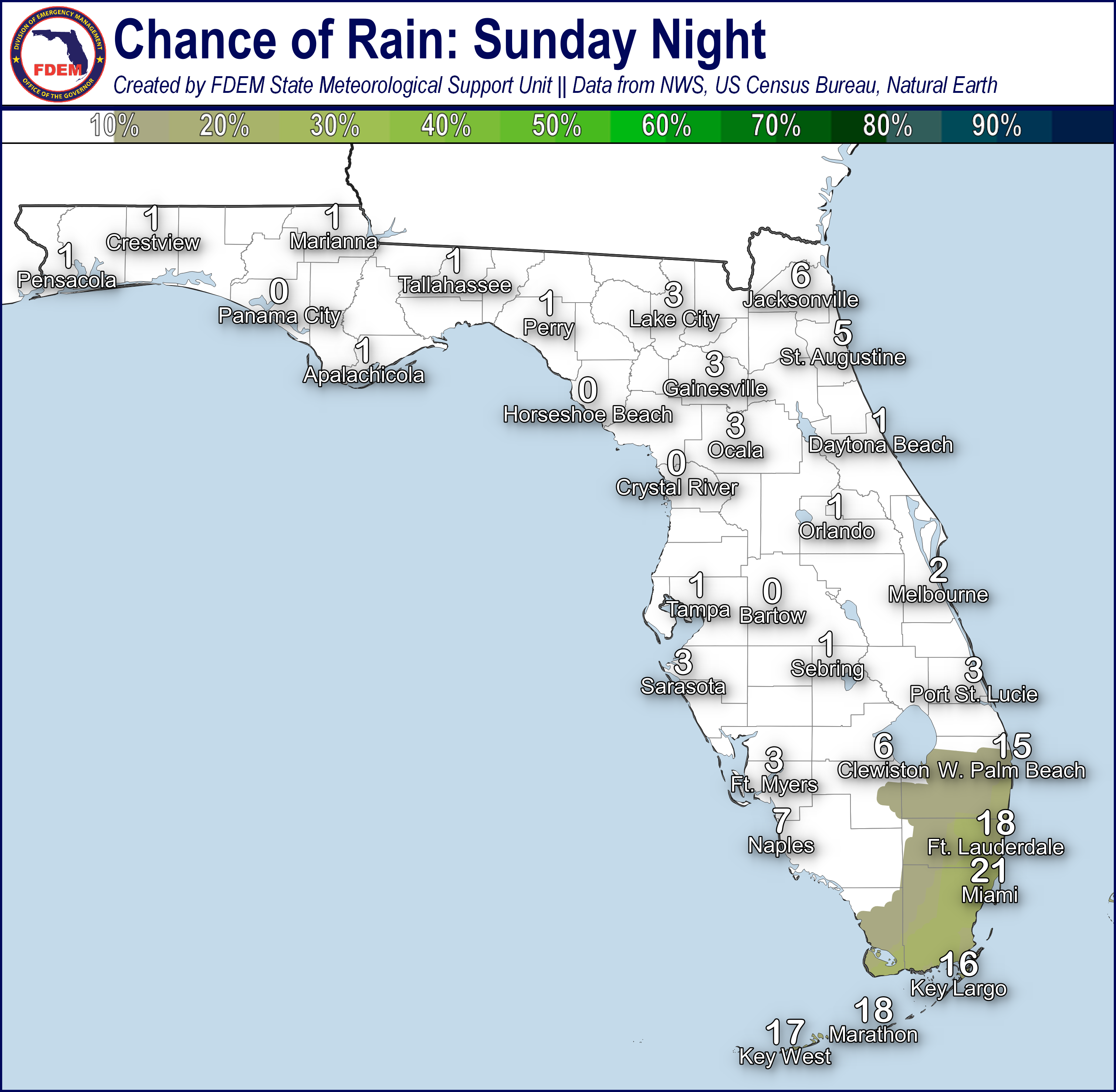
![]()
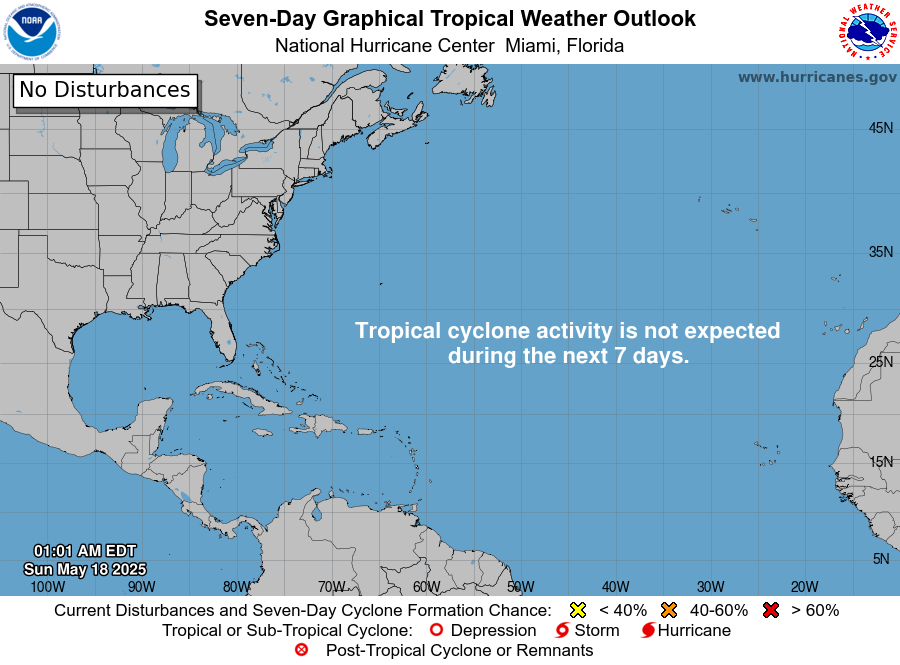
Hurricane season officially runs from June 1 to November 30.
For the latest on the tropics, please visit the National Hurricane Center (NHC) at www.hurricanes.gov.
![]()
Rip Currents: A high risk for rip currents extends nearly statewide due to large ocean swells and breezy onshore winds. A moderate risk extends along the Panhandle. For the latest Rip Current Outlook, visit www.weather.gov/beach.
Marine Hazards: Breezy onshore winds will lead to large ocean swells of 5-9’ along the Florida East Coast today, and a High Surf Advisory remains in effect through this evening and overnight for dangerous surf and beach conditions. Ocean swells will begin to gradually shift southward and away from the coast along the Panhandle and West Coast leading to wave heights of 1-3’ with isolated waves of 4’ along Apalachee Bay.
Red Tide was observed at background to medium concentrations in both Bay and Gulf counties and background to low concentrations in Franklin County. Red Tide was not observed in Southwest Florida or along the Florida East Coast (valid 12/12).
Coastal Flooding: There is no risk for coastal flooding across Florida.
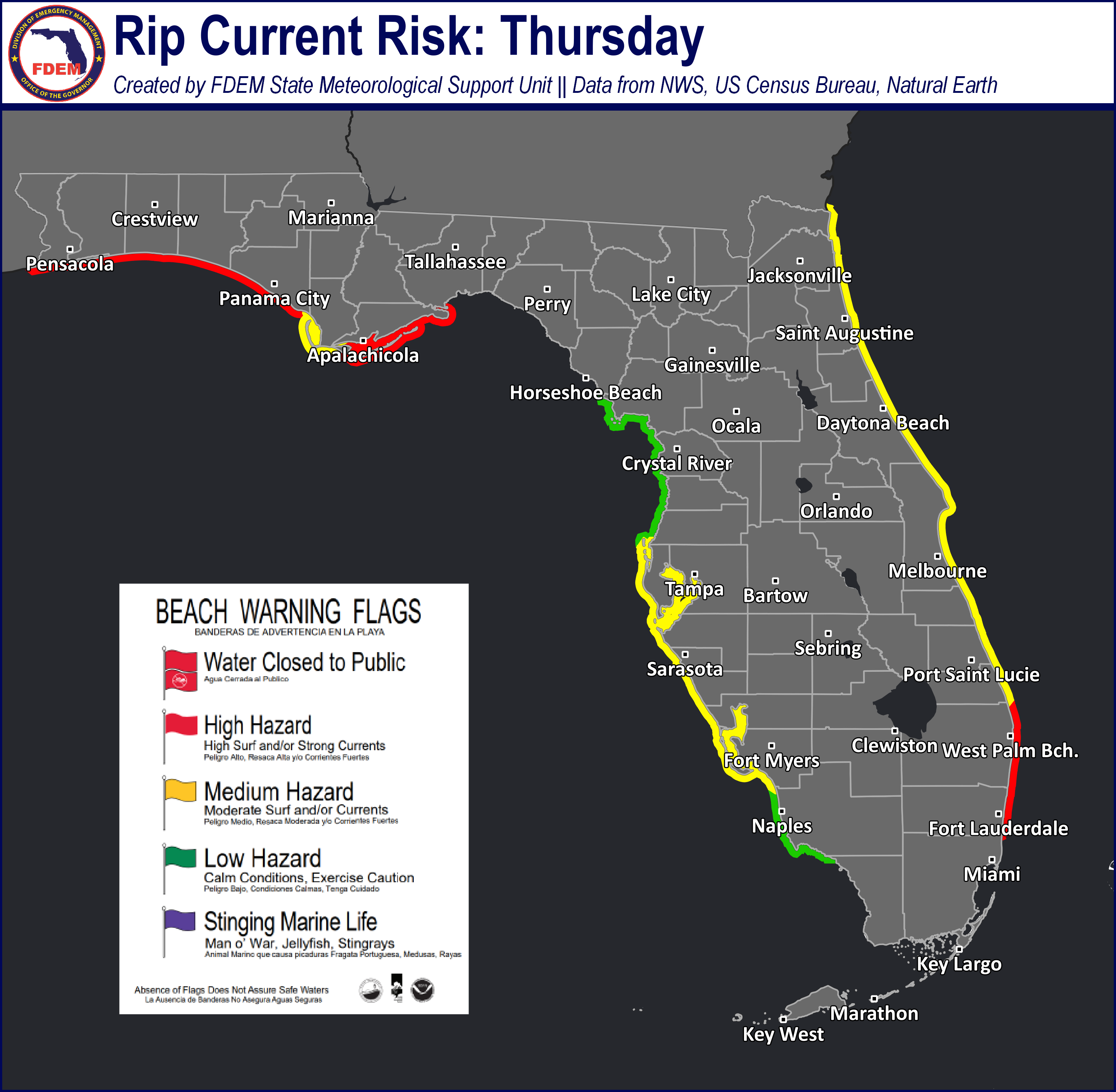
![]()
Fire Weather: Dry and cold air will filter into the state behind yesterday’s cold front that passed through and northeasterly winds. Relative humidity values will dip into critical thresholds across the I-10 corridor this afternoon leading to sensitive to elevated wildfire conditions with ongoing drought conditions. Breezy wind gusts of 15-20 mph will linger throughout North Florida, and into West-Central, this morning also helping to elevated wildfire conditions. Stronger wind gusts of 25-35 mph will persist across South Florida throughout the day, and a Wind Advisory remains in effect along coastal South Florida through this evening. According to the Florida Forest Service, there are 13 active wildfires across the state burning approximately 163 acres.
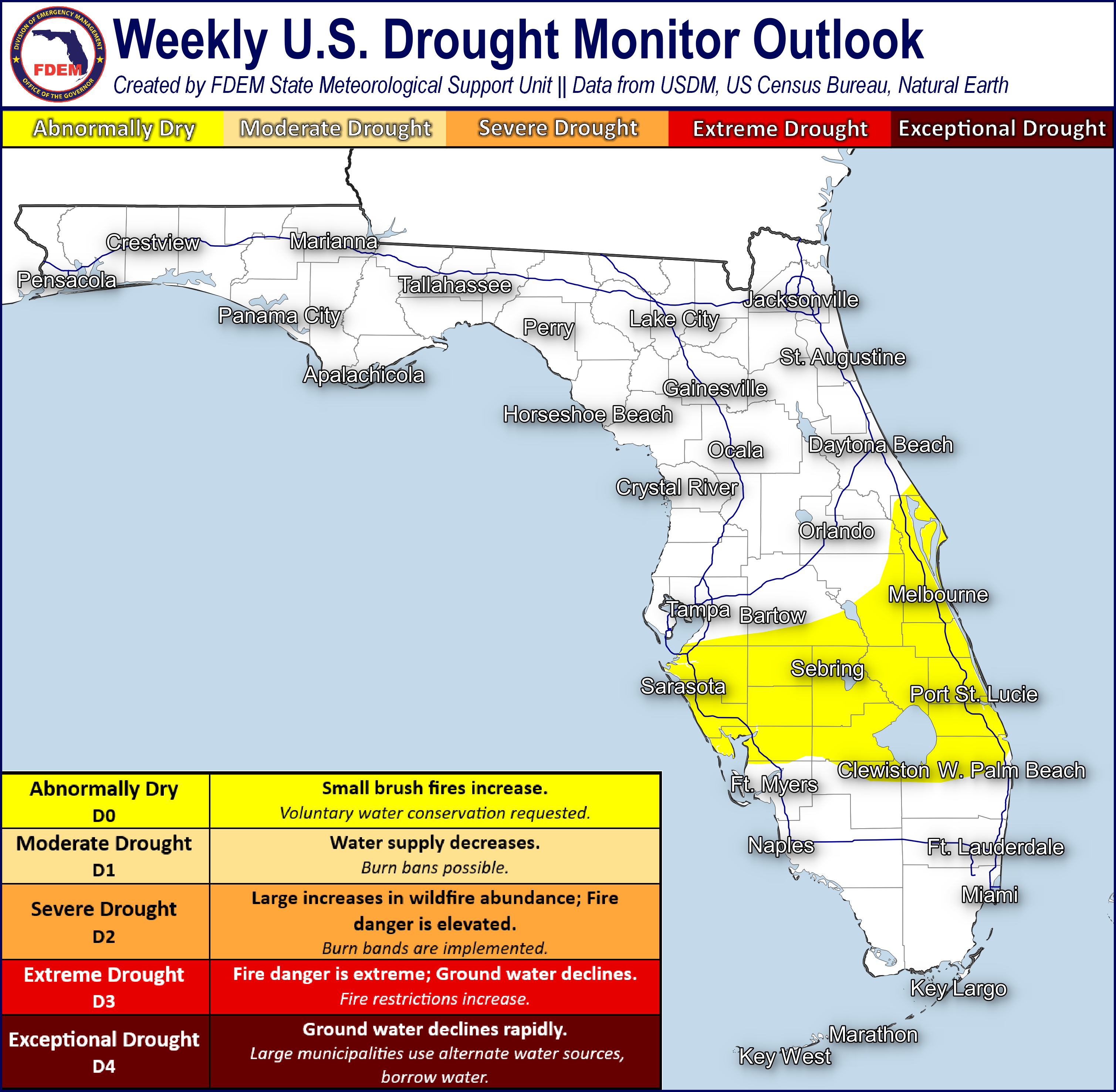
Drought (12/11): Widespread rainfall totals of 2-4 inches was observed across the Panhandle and North Florida over the past week as numerous rounds of showers and thunderstorms rolled through the area the past weekend and early this week. As a result, this week’s Drought Monitor outlook features some reduction in drought categories across much of North Florida. Last week’s Exceptional Drought has been downgraded to an Extreme Drought (level 3 of 4) across portions of Jackson, Calhoun, Liberty, Gadsden, Leon, Wakulla, Jefferson, and Madison counties. Severe Drought (level 2 of 4) remains in place cross much of the I-10 corridor from Baker County to Holmes County in North Florida, with Moderate Drought (level 1 of 4) across the rest of the western Panhandle and southward across the southern portions of the Suwannee River Valley. Some slight reduction in the Severe Drought (level 2 of 4) was seen over coastal West-Central Florida of northern Hillsborough and Pinellas County where some localized rainfall totals of 4-6 inches was observed in the past week. However, just south of that, expansion of the Severe Drought (level 2 of 4) was added over southern Sarasota and coastal Charlotte Counties where rainfall largely missed. A general couple of tenths of rain were observed over South Florida in the past week, not enough to curb the developing drought. Expansion of the Moderate Drought (level 1 of 4) was added to this week’s outlook across much of interior South Florida, with abnormally dry (emerging drought) conditions expanding to the Southeast Florida coastline. Although shorter-term rainfall departures are above normal due to the recent rainfall, portions of North Florida are still under a long-term rainfall deficit (60-90 days) and drought conditions will persist. Additionally, rainfall chances will remain very low over the next week, or longer, which may lead to a resumption of deteriorating drought conditions.
The Keetch-Byram Drought Index average for Florida is 411 (+5) on a scale from 0 (very wet) to 800 (very dry). There are 14 Florida counties that have an average KBDI above 500 (drought/increased fire danger).
![]()
Flash Flooding: There is no organized risk for flash flooding today. The heaviest rainfall should remain offshore from the Southeast Florida coast; however, an isolated downpour or thunderstorms could drift inland and produce locally upwards of 1” of rainfall. All other shower activity along the I-95 corridor and eastern coastline should remain light and brief.
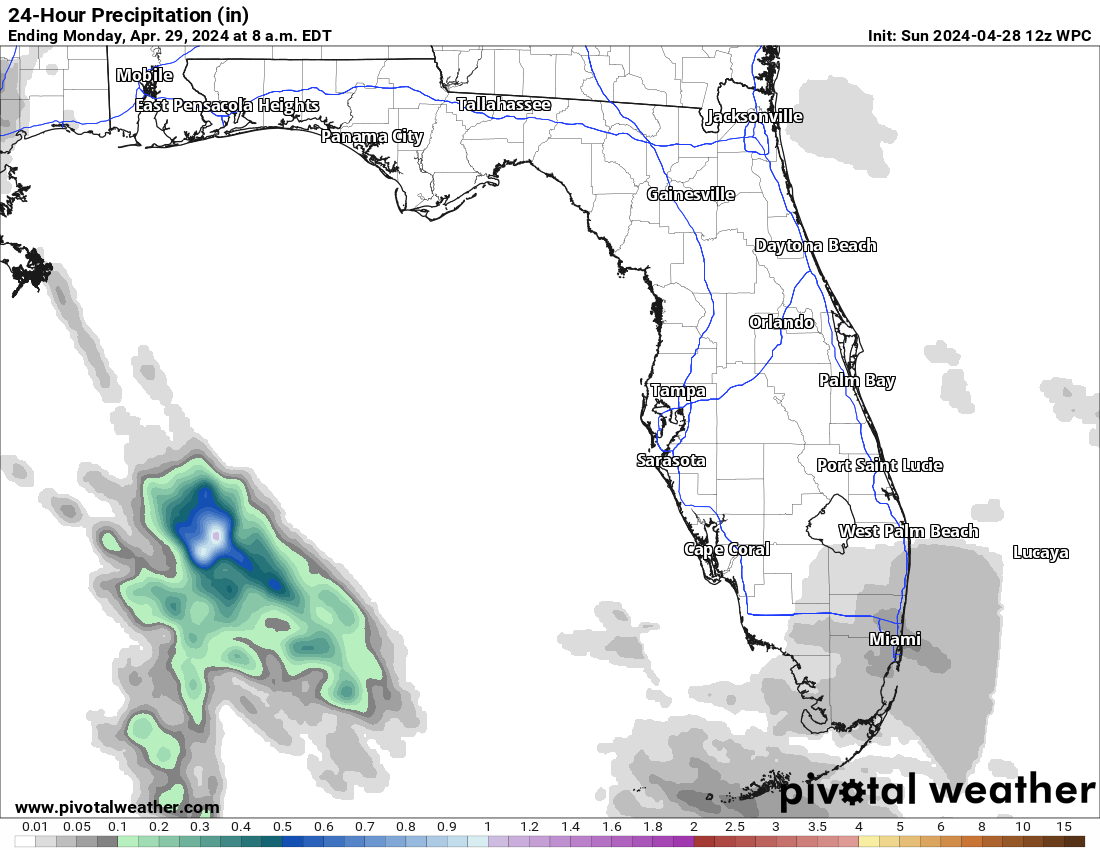
Riverine Flooding: There are no riverine concerns across Florida. For more information, visit the River Forecast Center.
Lake Okeechobee’s average elevation is 13.59 feet, which is within the operational band and is 1.14 feet below normal for this time of year.



